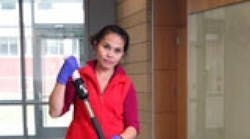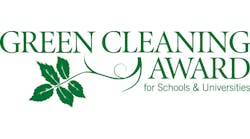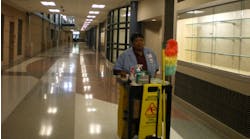Facilities Services takes green cleaning seriously when selecting equipment and instituting (best) practices within the industry. Recently, a couple of the most noteworthy activities have been to shift all the rest of the 173 buildings we service to a dayshift cleaning schedule, thus reducing energy consumption by not having to use night lighting, and implementing microfiber flat mops, which is estimated to prevent more than 800,000 gallons of water from entering the sewer system annually. Eight of the major buildings are serviced by team cleaning, thereby reducing duplication of effort, and reducing the amount of equipment required to clean an area when compared with traditional assignments.
But a good green-cleaning program cannot be carried out or maintained for very long without good training. Staff is trained continually in and provided guidelines on green-cleaning practices and procedures. To help ensure that its efforts are creating the results intended, the department is going beyond subjective impressions by committing products and procedures to objective, scientific analysis—becoming an industry leader in the process.
Custodial Services is always looking at ways to improve its green-cleaning and sustainability practices. About 1,600 Green Seal-certified foam hand soap dispensers have been converted across campus. The “Going Green” program includes a self-service desk-side trash element dubbed “Mini/Max” because of its emphasis on waste minimization (mini) and maximizing (max) recycling. The self-service model provides for centralized collection of both waste and recycling materials. The voluntary program has converted 2,625 work stations in 13 buildings to the self-service mode, thereby diverting an estimated 160,000 liners from reaching the landfill. Full implementation of the self-service model is expected mid-2011. As part of this program, custodians now are distributing composting bins in select locations. The custodial staff is instrumental in collecting compost. The additional time not spent on servicing desk-side trash receptacles is enabling the additional placement of public area compost bins in break rooms.
Cleaning Procedures and Strategies:
The university conducts floor-stripping, burnishing or cleaning effort during early mornings, and at times during evenings or nights when such efforts are least likely to negatively impact building occupants. The Environmental, Health, and Safety Department conducts air-sample surveys every 3 to 4 years of all custodial floor-care procedures to confirm no detectable release of hazardous substances. All custodians employ HEPA-filter backpack vacuums, primarily before building occupants arrive. Currently, 80 custodians work within zone-specialist cleaning (team cleaning) assignment, reducing water and electricity use because designated staff perform all restroom cleaning and vacuuming within an entire building. All building entrances have floor matting on the exterior and interior to help prevent soil from entering the buildings. The carpet crew uses Procycon for the nearly 2 million square feet of carpet they clean. The product has no packaging, being pumped directly into a 120-gallon container. Scientific devices, such as ATP detectors and air-sampling devices, help determine the efficiency of the university’s disinfecting and soil-removal processes.
Additional recycling collection containers are being placed in classrooms and conference rooms that include bins for waste, mixed paper, and cans and bottles. E-Media bins for the collection of small electronics and other electronic media are being added to additional buildings. Single public area waste containers are being removed in favor of sets of three public area bins that include waste, mixed paper, and cans and bottles. Copy centers, mail rooms and centralized office spaces continue to utilize a one or two “bagit” collection system for mixed paper. Wheeled 96-gallon collection carts have replaced bagit stations in areas that have space to accommodate them. Cardboard collection sites are established for multi-source contributors in one building. Self-service desk side recycling containers are available at each work station for faculty and administrative staff. Public area bins are provided in all university buildings to collect waste and recyclables. Paper clean-out carts are provided to departments at no charge to assist staff who are purging files or relocating. This effort contributes greatly to the current rate of diverting 55 percent of waste generated on campus from entering the landfill.
The university relies on durable floor-finishes to reduce the frequency of floor stripping and refinishing. Ride–on autoscrubbers assist in this, by reducing labor and the frequency for floor deep-cleaning projects, since the scrubbers maintain hallways daily, before dirt is ground into the finish. Vapor cleaners are used in the cleaning program. These are used for deep cleaning (and sanitizing) restrooms, especially in shower stalls and hard-to-clean areas, such as elevator tracks, metal plates in entry ways, radiators, etc. This eliminates harsh chemicals used for restorative cleaning.
Innovations:
In 2009, the school began testing for validation of green practices, working with experts to obtain objective data; conducted a beta test relying on integrated cleaning measurement (ICM) to discover how spray-and-vacuum/water-only cleaning compares to microfiber-traditional restroom cleaning methods.
In 2010, the school introduced the MINI-MAX Program (http://www.washington.edu/facilities/building/recyclingandsolidwaste/minimax); began random, objective testing of high-use touch points throughout spaces service by custodians; began using ATP devices (with plans to incorporate as part of a formal QA inspection/evaluation program.
Planned: beta test: Ionized water vs. chemical solution for hard-surface cleaning; beta test: Regular, dust cloths vs. microfiber dust cloths (including type); pilot comparison tests: Green Seal floor strippers; and hard-surface floor cleaning beta test: (microfiber) dust mopping vs. backpack vacuuming.
Story of innovation—Recycling: A self-service deskside trash element is dubbed “Mini/Max” because of its emphasis on waste minimization (mini) and maximizing (max) recycling. The voluntary program has converted 2,625 work stations in 13 buildings to the self-service mode, thereby diverting an estimated 160,000 liners from reaching the landfill.
Program Information
Number of students: 38,000
Square footage maintained: 10.9 million
Number of full-time custodians: 255
Annual cleaning budget: $10 million
Green cleaning team members: Gene Woodard, Director, Facilities Svcs., Building Services Dept.; Sattia Sear, Assistant Director; Scott Spencer, Asst. Director; XPEDX, Janitorial Product Distributor



